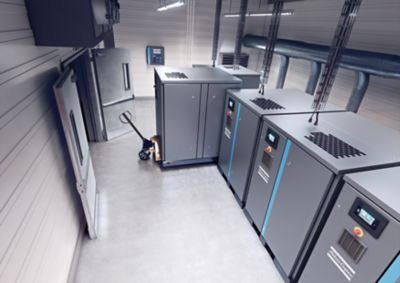Compressed CO2 vs compressed air
What is the difference between CO2 and compressed air?
Just like regular air, carbon dioxide (CO2) can also be compressed. And while both qualify as gasses, that is where most similarities end. There are, however, many differences between the two, so let’s take a look at what sets them apart.
Ease of compression of air compared to compression of CO2
Technically, we consider CO2 easier to compress compared to air, which means it produces less heat and, in this way, asks less of the equipment used for compression. However, this compression process also poses challenges.
One of them is the moisture that is being created. In the case of compressed air, this generally poses no major problem, given we drain it correctly. But the moisture generated during the compression of carbon dioxide creates carbonic acid. As a result, some precautions have to be taken to prevent corrosion in the equipment. This includes using stainless steel or specially coated material for components that can come in contact with the condensate.
Because CO2 is a heavier molecule, it can generate higher levels of vibrations and, if it is compressed too much (i.e. at high pressure), it can liquefy, which could result in damage to the compressor.
Carbon dioxide has a density of 1,5 at 0 ° C, compared to air.
The density of carbon dioxide under normal conditions of pressure and temperature is 1,977 kg / m3.
AIR 1.29 kg/m3 – CO2 1.97 kg/m3.
How to liquefy CO2?
How to choose the pressure to liquefy CO2 between the triple point (5.18 bar, −56.6 °C) and the critical point (73.8 bar, 31.1 °C) ? There are a lot of different parameters and the life cycle cost is affected by the liquefaction system, the compression system, the storage tanks, a CO2 carrier, etc. Usually, a good trade-off is around 15 / 20 bar (Corresponding to −27 °C / -20°C liquefaction temperature)
CO2 compressor versus air compressor design
That brings us to the hardware.
From the outside, and to the untrained eye, it would be difficult to tell an air compressor apart from a CO2 compressor. On the inside, however, there are some differences:
- As mentioned earlier, a CO2 compressor will feature more stainless steel to protect it against corrosion.
- Usually larger and more robust than an air compressor in order to deal with potentially higher stresses and vibrations.
- A CO2 compressor does not feature a direct inlet line. Since it needs to get the gas from a CO2 source, there is normally an inlet system where CO2 is treated before reaching the compressor.
Environmental concerns
As the name says, compressed air is simply ambient air that has been compressed. That means that it can be released back into the atmosphere (either intentionally through some piece of equipment or unintentionally through leaks in the compressed air system) at any point without causing any harm.
Carbon dioxide, however, is a harmful greenhouse gas, and its release into the atmosphere should be avoided if possible. Furthermore, while the air that is being compressed is safe to breathe, an accumulation of carbon dioxide in an enclosed space is a health hazard for anybody in the vicinity.
In order to avoid releasing carbon dioxide into the atmosphere, it could be stored and/or re-used in other applications.
Uses of compressed air versus uses of compressed carbon dioxide
Another major difference is how air and CO2 are used when compressed.
Generally, the air is compressed to be used, e.g. to power a pneumatic tool, to convey materials, operate a brake, etc.
Carbon dioxide, on the other hand, is compressed to be moved or stored more easily. Once compressed, CO2 could be used as a way to carbonate beverages, to create inert atmospheres in specific processes, or as a feedstock for chemical reactions.
Why CO2 compression now?
While some producers of carbon dioxide have been reusing or capturing their CO2 (using for this, CO2 compressors), most others have simply been releasing it into the air. However, as a result of environmental concerns, taxes and increasingly stringent regulations, so-called carbon-capturing is becoming an increasingly popular, sustainable, and less expensive option. And wherever CO2 needs to be captured, a compressor needs to be installed.

